Varicose veins in the legs (varicose veins - common name) - externally visible enlargement of the veins of the hemisphere, which develops as a result of varicose veins or post-thrombotic syndrome and is accompanied by a sharp violation of the outflow of the veins in the lower extremities.
Modern methods allow the treatment of varicose veins completely without incision and painless.
Complaints with varicose veins
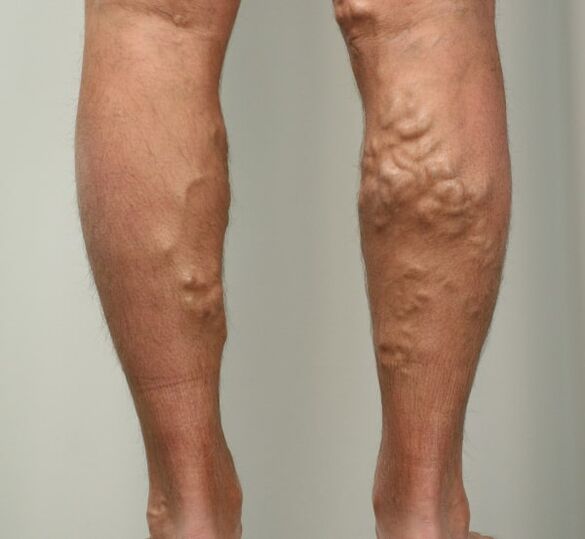
For many people, varicose veins and spider veins are just a cosmetic issue. In others, varicose veins cause pain and discomfort. Sometimes varicose veins lead to more serious problems and complications - thrombophlebitis or the appearance of trophic ulcers. Treatment is by removing or closing the varicose veins, which is the job of the vascular surgeon.
Varicose veins are complete degeneration of the venous wall, associated with a weakening of its connective tissue (varicose veins of the lower extremities), or develop with a sharp violation of the outflow of the veins, due to venous obstruction or overflow.
Causes of lower extremity varicose veins
Varicose veins lower extremities
This disease, which is the cause of varicose veins of the legs, occurs in 20-40% of the population in the developed world. For a long time, varicose veins were only a cosmetic defect, but the disease progressed severely, leading to pain, swelling of the feet, severe stages turning to dark leg skin, inflammatory complications and inflammation. leg vein ulcers.
Heredity is the main cause of primary varicose veins, however, the disease develops when the veins are overstressed. The mechanism that causes varicose veins of the lower extremities is due to overexertion, pregnancy and childbirth. In this case, there is a sharp increase in pressure in the veins of the lower extremities and damage to the valve apparatus, which provokes the mechanism for the development of the disease.
Postthrombophlebitic disease
Secondary varicose veins develop after venous thrombosis or as a result of congenital diseases (arterial fistula, congenital venous dysplasia). Postthrombotic disease is a complex, progressive pathological process in the venous system of the lower extremities. Due to valve failure or blockage of the deep veins, the hemispheric veins dilate as they overflow with blood. Another cause may be congenital or acquired arteriovenous fistula. Occasionally, congenital obstruction of the deep veins occurs, leading to secondary varicose veins (Klippel-Trenaunay syndrome).
Complications of varicose veins
More than 40% of women and 20% of men have varicocele. In 20% of cases, varicose veins lead to trophic ulcers, more than 25% of patients develop thrombophlebitis due to varicose veins. These complications often require serious treatment and pose a serious threat to health.
Chronic venous insufficiency
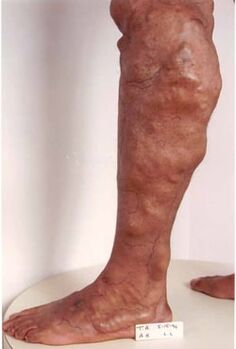
Obstruction of the outflow of a vein causes a medical condition known as chronic venous insufficiency. In the early stages of the disease, the appearance of single nodules of varicose veins can be noted, which is not cause for much concern, although they can sometimes be painful. Then there is an increase in the number of varicose veins. The disease progresses slowly but steadily. If the first appearance of varicose veins below the knee, the rate of development of the disease is much higher. If the disease does not go away, then gradually to stage 3 of venous insufficiency. Edema becomes permanent, dark skin appears in the ankle area, worse than anxiety in the legs, can persist even after resting overnight. Often develops thrombophlebitis due to varicose veins and dermatitis, eczema and dermatitis. The final stage of the development of varicose veins is the appearance of trophic ulcers.
Thrombophlebitis varicose veins
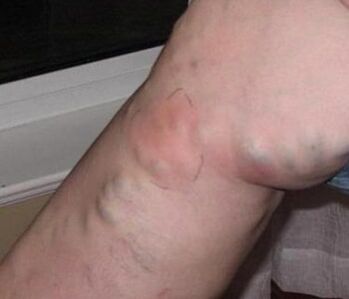
Thrombophlebitis is the most common complication of varicose veins. Thrombophlebitis is an inflammation of the vein wall, with the formation of blood clots in the vein lumen. Thrombophlebitis occurs in the superficial and deep veins. With venous insufficiency, thrombophlebitis occurs in 25% of patients and is usually superficial. The cause of thrombophlebitis in people with venous insufficiency is very slow blood flow, especially in large lymph nodes. Under these conditions, any factor that increases blood clotting (pregnancy, overheating, trauma, sprains, hypothermia and abrasions, acute respiratory infections) can cause the formation of blood clots. Intravenous blood clots and thrombophlebitis occur in 25% of patients with varicose veins of the lower extremities. Thrombophlebitis is caused by slowed blood flow in the veins. Thrombophlebitis can progress and lead to deep vein thrombosis. Chronic venous insufficiency is a painful condition with varicose veins accompanied by varicose veins. It is characterized by edema, tanning, appearance of trophic ulcers and varicose dermatitis.
Nutritional ulcer due to venous insufficiency
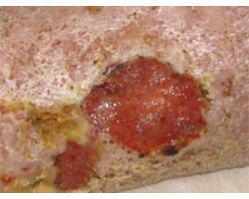
Nutritional ulcers are a sign of severe chronic venous insufficiency. This is a long-term non-healing wound that occurs with a severe violation of venous outflow through the superficial and deep veins. It occurs in 1% of the general population and in 20% of patients with venous disease. Every fifth patient with untreated varicose veins sooner or later develops a trophic ulcer. It can develop with both varicose veins and secondary varicose veins. Without removal of pathological venous wastes, a trophic ulcer due to varicose veins does not heal or continuously recurs. Nutritional ulcers with varicose veins occur in most patients and cause severe pain. Modern minimally invasive methods allow you to reliably remove trophic ulcers caused by varicose veins without incisions and painlessly.
Venous thromboembolism and thromboembolism
Pulmonary embolism is a serious complication of venous thrombosis. Varicose veins are an important risk factor for thrombophlebitis and deep vein thrombosis. Thromboembolism leads to the development of severe cardiac and respiratory failure, with a mortality rate of more than 50%.
Prevention of varicose veins of the lower extremities
Any modern person should clearly understand what varicose veins of the legs are, how to treat and prevent its occurrence. With a genetic predisposition, factors that contribute to varicose veins should be avoided. Indicates use of venotonic medication, wearing compression stockings during exercise, routine examination by a phlebologist, and venous ultrasound.
When working in multifactorial conditions, it is necessary to use class 1 compression stockings at work, do therapeutic exercises, be active outdoors, walk for at least 1 hour a day in medical socks, foot massage, swimming. Refusal to use oral contraceptives with complex genetics of varicose veins. It is better to follow these simple rules than to treat varicose veins in the legs.
Avoid factors produced during heavy work. For this, compression stockings are needed, especially with a predisposition to varicose veins. Medical knitwear is indicated for all pregnant women and in cases with a predisposition to varicose veins and thrombophlebitis, special compression stockings are used during childbirth. All pregnant women should see a phlebologist and have an ultrasound scan of their veins during the last weeks of pregnancy. This will help reduce the risk of problems with the venous system.
How to treat varicose veins in the legs
Over the past 10 years, the "barbaric" methods of treating varicose veins are becoming a thing of the past, thanks to the emergence of more gentle and effective methods successfully applied in clinics.
Venous sclerotherapy for varicose veins

Sclerotherapy is the introduction of a drug into the lumen of dilated veins, causing the walls to "glue" along with the disappearance of the veins. For sclerotherapy, several chemicals are used, there have been attempts to treat with ozone. At one point, the advent of foam therapy revolutionized venology. For the first time appeared an effective treatment for varicose veins without major surgery. Currently, foam sclerotherapy is used to remove medium-diameter veins after laser ablation of pathological discharges in the veins. Sclerotherapy is indispensable in the treatment of spider veins and reticular veins, where it has no real competition.
Laser treatment of varicose veins
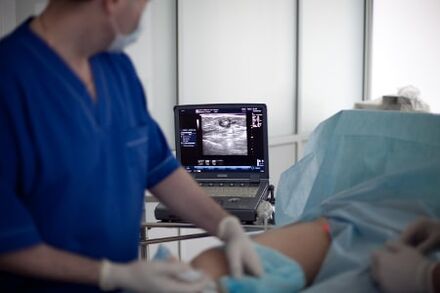
Varicose veins laser lower extremity laser treatment (EVLT) is the most modern, radical and inexpensive treatment, allowing you to both treat varicose veins and eliminate the cause of leg ulcers. . The significance of laser treatment lies in the internal heating of the vein wall and subsequent resorption of the dilated vein. The latest achievement in EVLT is the 1470 nm laser and radial light path, introduced into medical practice by radiologists. The postoperative period after this technique is completely painless and gives results that are superior to other treatments - the radical degree of laser intervention is at least 98%.
Surgery to remove varicose veins
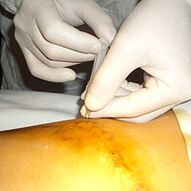
Surgical treatment of varicose veins with resection of the main venous trunks is a thing of the past. The risk of complications from a radical vein ablation forced veniologists to look for other approaches, leading to the development of laser techniques and other thermal vein ablation methods. However, according to Müller and Varadi, changing the classic veinectomy approach to small vein ablation allows for an excellent combination of laser treatment and removal of large veins throughthrough punctures without incisions or sutures. Varadi's technique saved the patient from the pain of large varicocele. Mini varicose vein ablation allows you to both treat varicose veins and remove visible veins anywhere on the body.
Radiofrequency eradication of varicose veins

Radiofrequency ablation (RFO) of varicose veins of the legs is a modern and safe treatment. This method is based on the use of microwaves heating a metal probe, which is already the wall of the vein and causing destruction of the inner membrane. In terms of painlessness, this method corresponds to the 1470 nm laser coagulation method, which is easy to perform and less painful after surgery. However, RFO is much inferior to laser in terms of long-term treatment results. RFO efficacy was 85% without recurrence. This method is not suitable for treating perforated veins.
Massage and bath for varicose veins
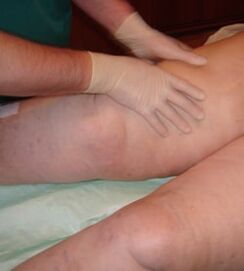
Massage is an active treatment for varicose veins.
All types of modern massage are used, especially in pathologies of the lymphatic and venous systems. Among the exclusive methods must mention the technology of lymphatic drainage massage combined with bandaging, which is very effective in treating chronic venous insufficiency.
In chronic venous insufficiency, massage is used to rule out increased venous pressure in venous insufficiency and post-thrombotic syndrome. This combination of massage with dressings allows you to effectively eliminate all clinical manifestations of the disease.
Bathing when having varicose veins, thrombophlebitis or post-thrombotic disease is very dangerous. Any heat stress can cause the formation of blood clots in the deep veins with all the consequences that follow.
Unfortunately, a complete cure for varicose veins cannot be achieved without removing waste products from the veins and varicose veins. Although the reduction of symptoms associated with stagnation of venous blood in the legs is quite possible with the help of modern therapy. However, the prevalence of varicose veins and chronic venous insufficiency sometimes gives rise to a desire to speculate on the matter. Consider modern and deceptive treatments.
Varicose veins treatment
The goals of drug therapy for venous disease are to relieve symptoms and prevent complications, but these goals are not easily achieved. Today, the abundance of means that can be applied raises another problem: which one to choose? Unfortunately, most of the proposed drugs have rather low efficacy, despite theoretically proven efficacy. This is due to a number of reasons, the main of which is the low absorption of the active ingredients of these drugs by the body. An ideal drug for the treatment of venous insufficiency should affect as many of the pathogenesis of chronic venous insufficiency as possible, while having the fewest side effects and being highly absorbed by the body. A fairly large number of venotonic agents are present on the modern pharmaceutical market. However, they have similar medicinal properties (plant flavonoids) and therefore the effectiveness of one drug or another depends solely on the concentration and digestibility of the active principle.
You should not expect the disappearance of varicose veins from these drugs, however, the legs are light, the edema is reduced and the night cramps disappear.
Varicose veins cream and gel
Despite the high effectiveness advertised by sellers and manufacturers, creams and gels do not provide effective relief from varicose veins, and varicose veins do not disappear from them. In the early stages of venous insufficiency, venerealists are not opposed to the use of these agents, since their rubbing promotes venous outflow, like gentle massage, and has a beneficial effect. skin soothing. With advanced forms of venous insufficiency, these creams and ointments can cause dermatitis and allergies, and are therefore very harmful. Several drugs are used in the development of acute thrombophlebitis and help to calm the inflammatory process, but varicose veins do not disappear from them. Thanks to the right advertising, the shaman's leech treatment products have been very popular with the people, but they have no attitude towards medicinal drugs, even leeches and have no expectations from them. .
Drugs to treat blood clots in varicose veins
A common complication of venous insufficiency is thrombophlebitis, especially during pregnancy and postpartum. One drug that has been shown to prevent blood clots is the low molecular weight acidic sulfur-containing glycosaminoglycan. To prevent thrombophlebitis after treatment of varicose veins, tablets are used in clinics. They are performed 7 days after laser or radiofrequency intervention.
Compression stockings for varicose veins
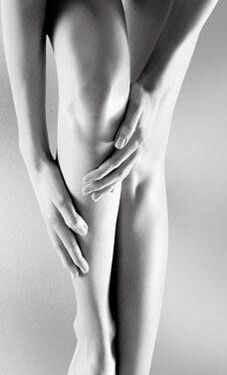
Compression knit fabric is undoubtedly one of the most effective means of treating venous edema and reducing the degree of chronic venous insufficiency. Invented over 100 years ago, gaining immense popularity in the 20th century and even more so in the 21st, compression stockings and stockings have become an integral part of the treatment ofvein doctor. This is because of the effects it has:
- improve the outflow of veins and lymph from the lower extremities,
- improve microcirculation,
- slow the progression of the disease,
- prevention of complications of varicose veins (phlebitis, nutritional disorders),
- prevention of deep vein thrombosis.
How to use compression stockings
So, if you have varicose veins and have a treatment plan, then definitely during your treatment you will use compression stockings for a period of several days or months (individually). If your feet are swollen at the end of the day after work and you have heavy foot syndrome, you can also use compression socks during the day to avoid these symptoms at night. If you have an untreated complication of varicose veins - trophic ulcers or thrombophlebitis - you will also use compression to improve the condition of your legs and relieve uncomfortable symptoms.
The fact is that by improving the flow of veins, compression stockings work every second of being worn to improve the return of venous blood from the legs, which is certainly not easy for veins damaged bydiseases and go against the law of universal gravitation. Compression knitwear can be safely called one of the ingenious inventions of mankind, but in order for it to work for you, you must meet a few conditions:
- Compression knitwear is selected individually (according to standards). The main requirement is to adhere to the anatomical structure of the limb and, therefore, to produce the correct pressure gradient.
- Knitted clothing is selected by an individual doctor (phlebologist). Medical products are marked in mm Hg, and are divided into compression grades 1, 2, 3, 4. Each compression level corresponds to a certain pressure. At different stages of varicose veins or chronic venous insufficiency, the appropriate type of compression is used. That is why only a doctor has the right to prescribe and choose the right compression stocking - taking into account the nature of the pathology and according to individual standards.
- It should be medical, not thin knitwear. Only proven brands with RAL certification.
When do you need knitwear for varicose veins?
- correcting "heavy leg" syndrome: reducing severity, edema, improving quality of life;
- during treatment with a phlebologist: after surgery or for a period specified by a specialist;
- to slow the progression of varicose veins;
- to treat complications of varicose veins (phlebitis).
An essential component of any treatment for varicose veins and chronic venous insufficiency is medical elastic compression. Thanks to compression therapy, it is possible to completely eliminate swelling and heaviness in the legs and make it possible for any type of varicose veins to be completely treated. Modern medical knitwear has a high therapeutic effect and excellent aesthetics.
Tape |
Therapy shirt |
|---|---|
The generation of required pressure is determined by the technique and skill of the physician or patient |
Process profile and pressure level specified during production in accordance with the compression grade |
Necessity of medical involvement in dressing or patient education |
Physician involvement is limited to the choice of compression grade and product type |
Difficulty in providing compression and fixation on the thigh |
Provides effective compression and immobilization of the thigh |
Used for non-standard limb shapes |
With non-standard shape of the limb, customizable |
Daily washing causes the tape to wear out quickly |
Daily washing is required to maintain compression properties |
Needs to be replaced after many washes |
Guaranteed preservation of compressive properties for 6 months |
May violate the water balance and temperature of the skin |
Porous bonding provides normal temperature and water balance of the skin |
Low aesthetics, providing convenience and comfort |
High aesthetics, convenient and comfortable to use |
Exercises and sports for varicose veins
Strength sports for varicose veins and athletics can be performed after the varicose veins have been removed, or in compression stockings with 2-3 layers of compression. Modern treatments can bring varicose veins back to normal, eliminating any restrictions.
We bring you a complex combination of therapeutic and preventive exercises developed by leading experts. Regular practice will help minimize the manifestations of venous insufficiency of the lower extremities, slow the progression of the disease and reduce the risk of life-threatening complications.
- Leg varicose veins. Breathe deeply and evenly, lie down, close your eyes, relax. At the same time, place several pillows under your feet so that they are raised at an angle of 15-20°
- Exercise bike. Lying on your back and breathing evenly, imagine that you are riding a bicycle.
- The exercise consists of several parts, which are performed slowly and rhythmically. Lie on your back, legs extended, take a deep breath. Exhale, bend your right leg, bringing your knee toward your chest. Inhale, straighten your legs upwards. Exhale, lower. Repeat this exercise alternately for each leg.
- Lie on your back, arms along your body, lifting your legs straight up. Simultaneously rotate both legs inward, then outward.
- Alternately flex and do not flex the foot at the ankle joint forward and backward.
- Alternately bend and unbend your toes.
- Stand in a standing position: feet together, hands along the body. After taking a deep breath, slowly raise your toes, exhale back to the starting position.
- Walk in place without lifting your socks off the floor.
- Vertical drag. Lie on your back, arms along your body, breathing evenly, take turns crossing your legs, alternately.
- Lie on your back, bending your knees without lifting your feet off the floor. Place your hands on your hips. Inhale slowly, raising your head and torso. Simultaneously, the hands slide down to the knees. Slowly exhale, return to the starting position.
- Lie on your back, arms along the body, legs at an angle of 15-20 °, between the feet place a small pillow. Inhale slowly, bend your waist, rip your butt off the mattress. Slowly exhale, return to the starting position.
- Lie on your back, arms along your body, knees bent, feet on the floor. Exhale slowly, drawing in the abdomen. Inhale slowly, inflating the abdomen.
- Lie on your back with your legs raised to a 15-20° angle. Bend right leg, bringing knee toward chest. At the same time, hold your feet tightly with your hands. Slowly straighten your legs. Grasp the legs with both hands, slide along the calves to the level of the knees. Slowly lower your legs, hands sliding on your thighs. The exercise is repeated for the other leg.
- Stand with your feet together, hands along your body, slowly inhale, draw your shoulders back, slowly exhale, relax your shoulders and tilt your head forward.
- Contrast shower on foot. Alternating hot and cool water jets. 5-10 minutes for each leg.












































